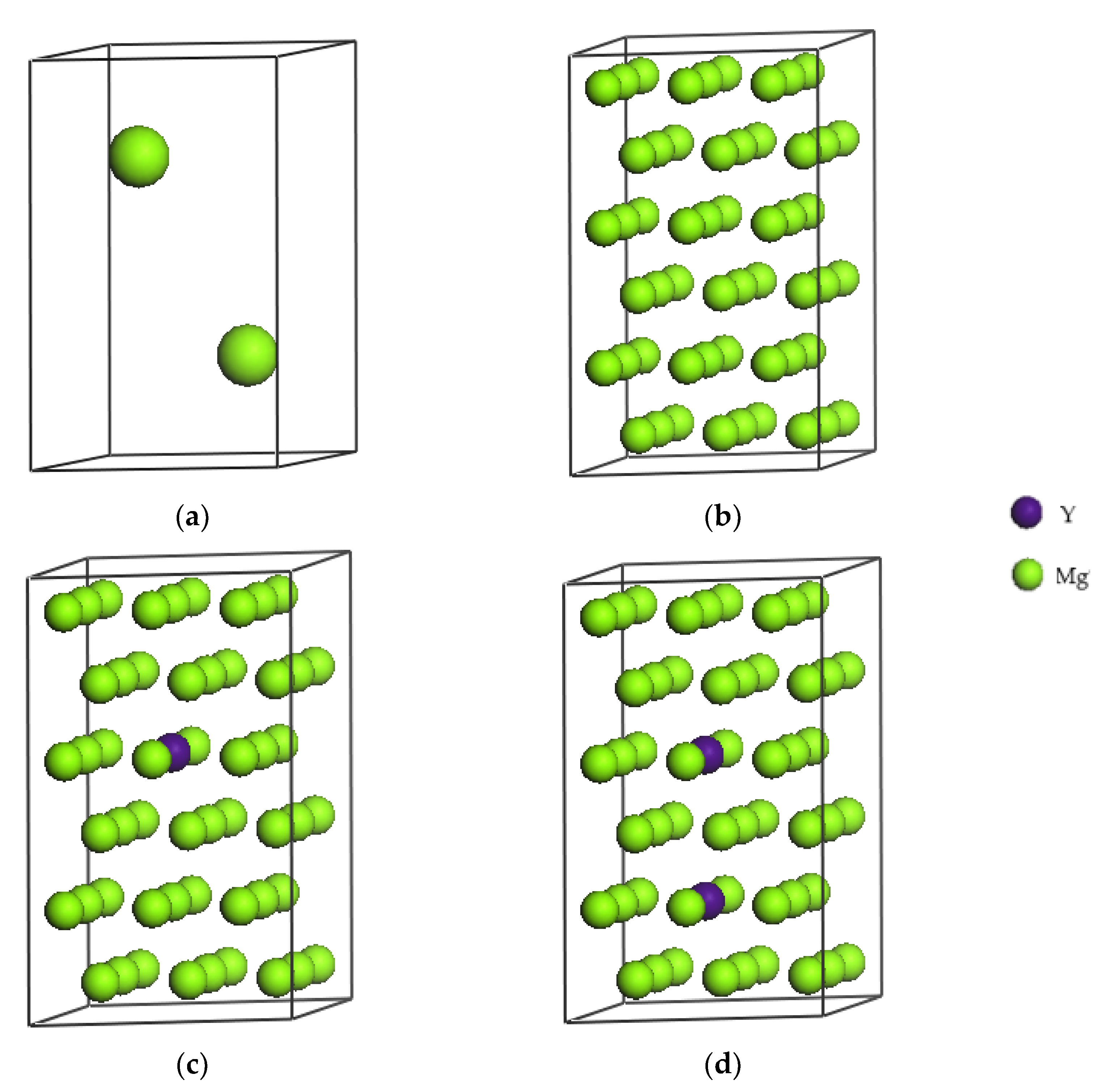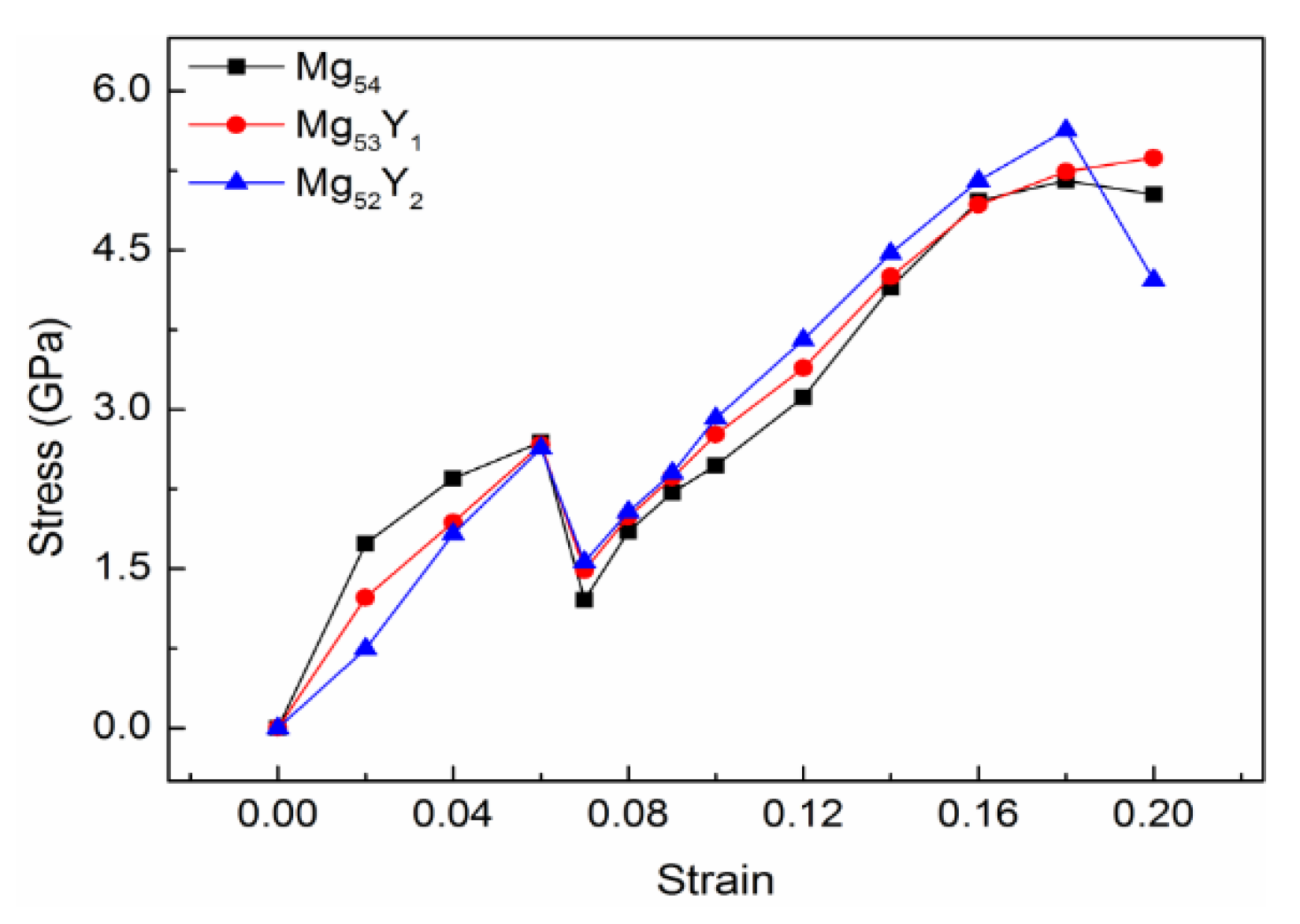Effects of the Rare Earth Y on the Structural and Tensile Properties of Mg-based Alloy: A First-Principles Study
Abstract
:1. Introduction
2. Computational Methods
3. Results and Discussion
3.1. Structure Properties
3.2. Tensile Properties
4. Conclusions
Author Contributions
Funding
Institutional Review Board Statement
Informed Consent Statement
Data Availability Statement
Conflicts of Interest
References
- Patel, H.A.; Chen, D.L.; Bhole, S.D.; Sadayappan, K. Microstructure and tensile properties of thixomolded magnesium alloys. J. Alloys Compd. 2010, 496, 140–148. [Google Scholar] [CrossRef]
- Bakhsheshi-Rad, H.R.; Abdellahi, M.; Hamzah, E.; Ismail, A.F.; Bahmanpour, M. Modelling corrosion rate of biodegradable magnesium-based alloys: The case study of Mg-Zn-RE-xCa (x=0, 0.5, 1.5, 3 and 6wt%) alloys. J. Alloys Compd. 2016, 687, 630–642. [Google Scholar] [CrossRef]
- Kurzynowski, T.; Pawlak, A.; Smolina, I. The potential of SLM technology for processing magnesium alloys in aerospace industry. Arch. Civ. Mech. Eng. 2020, 20, 1–13. [Google Scholar] [CrossRef] [Green Version]
- Wu, M.M.; Jiang, Y.; Wang, J.W.; Wu, J.; Tang, B.Y.; Peng, L.M.; Ding, W.J. Structural, elastic and electronic properties of mg(cu 1 x zn x ) 2 alloys calculated by first-principles. J. Alloys Compd. 2011, 509, 2885–2890. [Google Scholar] [CrossRef]
- Wang, M.; Xu, X.Y.; Wang, H.Y.; He, L.; Huang, M. Evolution of dislocation and twin densities in a Mg alloy at quasi-static and high strain rates. Acta Mater. 2020, 201, 102–113. [Google Scholar] [CrossRef]
- Luo, Z.; Chen, X.H.; Song, K.; Liu, C.Q.; Dai, Y.; Zhao, D.; Pan, F.S. Effect of Alloying Element on Electromagnetic Interference Shielding Effectiveness of Binary Magnesium Alloys. Acta Metall. Sin. 2019, 32, 817–824. [Google Scholar] [CrossRef] [Green Version]
- Yang, C.; Pan, F.; Chen, X.; Luo, N. Effects of Sm addition on electromagnetic interference shielding property of Mg-Zn-Zr alloys. Appl. Phys. A 2017, 123, 400.1–400.7. [Google Scholar] [CrossRef]
- Guan, K.; Li. B.; Yang, Q.; Qiu, X.; Tian, Z.; Meng, J. Effects of 1.5 wt% samarium (Sm) addition on microstructures and tensile properties of a Mg-6.0Zn-0.5Zr alloy. J. Alloys Compd. 2018, 735, 1737–1749. [Google Scholar] [CrossRef]
- Zucchi, F.; Grassi, V.; Frignani, A.; Monticelli, C.; Trabanelli, G. Electrochemical behaviour of a magnesium alloy containing rare earth elements. J. Appl. Electrochem. 2006, 36, 195–204. [Google Scholar] [CrossRef]
- Rao, J.; Li, H. Oxidation and ignition behavior of a magnesium alloy containing rare earth elements. Int. J. Adv. Manuf. Tech. 2010, 51, 225–231. [Google Scholar] [CrossRef]
- Tsai, Y.; Chou, C.; Jeng, R.; Lee, S.; Lin, C. Effect of rare earth elements addition on microstructures and mechanical properties of A356 alloy. Int. J. Cast Metal. Res. 2011, 24, 83–87. [Google Scholar] [CrossRef]
- Coy, A.E.; Viejo, F.; Skeldon, P.; Thompson, G.E. Susceptibility of rare-earth-magnesium alloys to micro-galvanic corrosion. Corros. Sci. 2010, 52, 3896–3906. [Google Scholar] [CrossRef]
- Yang, M.B.; Hou, M.D.; Zhang, J.; Pan, F.S. Effects of Ce, Y and Gd additions on as-cast microstructure and mechanical properties of Mg-3Sn-2Sr magnesium alloy. Trans. Nonferr. Metal. Soc. 2014, 24, 2497–2506. [Google Scholar] [CrossRef]
- Gorny, A.; Bamberger, M.; Katsman, A. High temperature phase stabilized microstructure in Mg-Zn-Sn alloys with Y and Sb additions. J. Mater. Sci. 2007, 42, 10014–10022. [Google Scholar] [CrossRef]
- Yang, M.; Pan, F. Effects of Y addition on as-cast microstructure and mechanical properties of Mg-3Sn-2Ca (wt.%) magnesium alloy. Mat. Sci. Eng. A 2009, 525, 112–120. [Google Scholar] [CrossRef]
- Huang, X.; Suzuki, K.; Saito, N. Textures and stretch formability of Mg-6Al-1Zn magnesium alloy sheets rolled at high temperatures up to 793 K. Scr. Mater. 2009, 60, 651–654. [Google Scholar] [CrossRef]
- Chen, H.L.; Lin, L.; Mao, P.L.; Liu, Z. Phase stability, electronic, elastic and thermodynamic properties of Al-RE intermetallics in Mg-Al-RE alloy: A first principles study. J. Magnes. Alloys 2015, 3, 197–202. [Google Scholar] [CrossRef] [Green Version]
- Wang, C.; Han, P.; Zhang, L.; Zhang, C.; Yan, X.; Xu, B. The strengthening effect of Al atoms into Mg-Al alloy: A first-principles study. J. Alloys Compd. 2009, 482, 540–543. [Google Scholar] [CrossRef]
- Zhang, Y.; Lü, G.H.; Deng, S.H.; Wang, T.M. First-principles computational tensile test on an Al grain boundary. Acta Phys. Sin. 2006, 55, 2901–2907. (In Chinese) [Google Scholar]
- Wang, C.; Huang, T.L.; Wang, H.Y.; Xue, X.N.; Jiang, Q.C. Effects of distributions of Al, Zn and Al+Zn atoms on the strengthening potency of Mg alloys: A first-principles calculations. Comp. Mater. Sci. 2015, 104, 23–28. [Google Scholar] [CrossRef]
- Luo, S.Q.; Tang, A.T.; Pan, F.S.; Song, K.; Wang, W.Q. Effect of mole ratio of Y to Zn on phase constituent of Mg-Zn-Zr-Y alloys. Trans. Nonferr. Metal. Soc. 2011, 21, 795–800. [Google Scholar] [CrossRef]
- Tong, L.B.; Li, X.H.; Zhang, H.J. Effect of long period stacking ordered phase on the microstructure, texture and mechanical properties of extruded Mg-Y-Zn alloy. Mater. Sci. Eng. A 2013, 563, 177–183. [Google Scholar] [CrossRef]
- Giusepponi, S.; Celino, M. The ideal tensile strength of tungsten and tungsten alloys by first-principles calculations. J. Nucl. Mater. 2013, 435, 52–55. [Google Scholar] [CrossRef]
- Mao, P.; Yu, B.; Liu, Z.; Wang, F.; Ju, Y. First-principles calculations of structural, elastic and electronic properties of AB2 type intermetallics in Mg-Zn-Ca-Cu alloy. J. Magnes Alloys 2013, 1, 256–262. [Google Scholar] [CrossRef] [Green Version]
- Mao, P.L.; Yu, B.; Liu, Z.; Wang, F.; Ju, Y. Mechanical, electronic and thermodynamic properties of Mg2Ca Laves phase under high pressure: A first-principles calculation. Comp. Mater. Sci. 2014, 88, 61–70. [Google Scholar] [CrossRef]
- Gironcoli, S.D.; Baroni, S.; Resta, R. Piezoelectric properties of III-V semiconductors from first-principles linear-response theory. Phys. Rev. Lett. 1989, 62, 2853–2856. [Google Scholar] [CrossRef] [PubMed]
- Wang, F.; Sun, S.J.; Wang, Z.; Yu, B.; Mao, P.L.; Liu, Z. Microstructure, mechanical properties and first-principle analysis of vacuum die-cast Mg-7Al alloy with Sn addition. Rare Metals 2015, 15, 1–7. [Google Scholar] [CrossRef]
- Jing, Z.; Zhang, X.; Li, W.; Pan, F.; Guo, Z. Partition of Er among the constituent phases and the yield phenomenon in a semi-continuously cast Mg-Zn-Zr alloy. Scr. Mater. 2010, 63, 367–370. [Google Scholar]
- Lin, L.; Chen, L.; Liu, Z. Tensile strength improvement of an Mg-12Gd-3Y (wt%) alloy processed by hot extrusion and free forging. J. Mater. Sci. 2008, 43, 4493. [Google Scholar] [CrossRef]
- Zheng, A. Effect of Rare Earth Y Content on Microstructure and Mechanical Property of Mg Alloy. Hot Working Technol. 2016, 4, 40–42. (In Chinese) [Google Scholar]


| Strain (%) | |||
|---|---|---|---|
| Mg54 | Mg53Y1 | Mg52Y2 | |
| 0 | −193.46 | −199.66 | −205.63 |
| 2 | −193.01 | −199.40 | −205.52 |
| 4 | −192.44 | −198.95 | −205.15 |
| 6 | −191.70 | −198.28 | −204.49 |
| 7 | −191.41 | −197.97 | −204.33 |
| 8 | −191.37 | −197.74 | −204.08 |
| 9 | −190.90 | −197.43 | −203.77 |
| 10 | −190.47 | −196.97 | −203.32 |
| 12 | −189.77 | −196.15 | −202.43 |
| 14 | −188.75 | −195.08 | −201.29 |
| 16 | −187.46 | −193.77 | −199.92 |
| 18 | −186.00 | −192.32 | −198.84 |
| 20 | −184.60 | −190.84 | −197.64 |
| Strains (%) | Stress, GPa | ||
|---|---|---|---|
| Mg54 | Mg53Y1 | Mg52Y2 | |
| 0 | 0.00 | 0.00 | 0.00 |
| 2 | 1.74 | 1.23 | 0.75 |
| 4 | 2.35 | 1.94 | 1.83 |
| 6 | 2.69 | 2.67 | 2.63 |
| 7 | 1.21 | 1.49 | 1.57 |
| 8 | 1.85 | 1.99 | 2.04 |
| 9 | 2.22 | 2.36 | 2.40 |
| 10 | 2.47 | 2.76 | 2.92 |
| 12 | 3.11 | 3.39 | 3.65 |
| 14 | 4.15 | 4.25 | 4.47 |
| 16 | 4.97 | 4.93 | 5.15 |
| 18 | 5.15 | 5.24 | 5.63 |
| 20 | 5.02 | 5.37 | 4.22 |
Publisher’s Note: MDPI stays neutral with regard to jurisdictional claims in published maps and institutional affiliations. |
© 2021 by the authors. Licensee MDPI, Basel, Switzerland. This article is an open access article distributed under the terms and conditions of the Creative Commons Attribution (CC BY) license (https://creativecommons.org/licenses/by/4.0/).
Share and Cite
Gao, Y.; Wu, C.; Feng, W.; He, Y.; He, H.; Yang, J.; Chen, X. Effects of the Rare Earth Y on the Structural and Tensile Properties of Mg-based Alloy: A First-Principles Study. Crystals 2021, 11, 1003. https://doi.org/10.3390/cryst11081003
Gao Y, Wu C, Feng W, He Y, He H, Yang J, Chen X. Effects of the Rare Earth Y on the Structural and Tensile Properties of Mg-based Alloy: A First-Principles Study. Crystals. 2021; 11(8):1003. https://doi.org/10.3390/cryst11081003
Chicago/Turabian StyleGao, Yan, Chuang Wu, Wenjiang Feng, Yan He, Haisheng He, Jingyu Yang, and Xiuyan Chen. 2021. "Effects of the Rare Earth Y on the Structural and Tensile Properties of Mg-based Alloy: A First-Principles Study" Crystals 11, no. 8: 1003. https://doi.org/10.3390/cryst11081003
APA StyleGao, Y., Wu, C., Feng, W., He, Y., He, H., Yang, J., & Chen, X. (2021). Effects of the Rare Earth Y on the Structural and Tensile Properties of Mg-based Alloy: A First-Principles Study. Crystals, 11(8), 1003. https://doi.org/10.3390/cryst11081003





